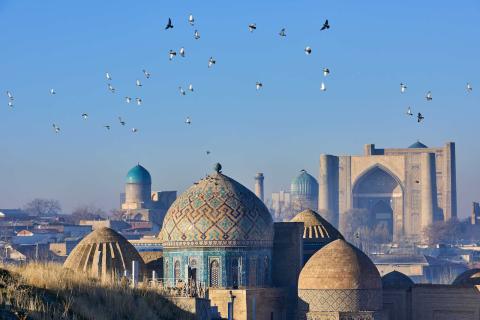Trade data shows Central Asia’s imports from China are up sharply, as the region is progressively integrated into a Beijing-Moscow economic axis.
Central Asia is increasingly a pass-through for Sino-Russian trade. There are now fresh reports of illicit supplies being funnelled to Russia via the region hidden within a broader export surge.
If Kazakhstan, Kyrgyzstan, Tajikistan and Uzbekistan were somehow wrapped into a single economy, that entity would account for roughly US$70 billion in goods trade, on par with China’s total goods trade with Chile but below its trade with countries such as Thailand, Mexico and the Philippines.
Although Central Asia barely cracks the top 25 of China’s largest trading partners by value, it is nevertheless an important economic and strategic partner for Beijing.
That’s not only because of Central Asia’s vital natural gas exports to China. Central Asian countries (and Belarus) are serving as a “cutout” for Sino-Russian trade – so while China’s official goods exports to Central Asia have risen sharply over the last year, many of these shipments are in fact quickly re-exported to Russia, bolstering the Kremlin’s war effort.
Chinese exports have more than doubled since 2021
While there is a focus on restraining Russia’s exports, its imports are more valuable for sustaining its wartime capacity from a near-term, tactical perspective. Without imports, Russian economic policymakers would not only face goods shortages and resultant inflation but would also have to make difficult “guns vs butter” tradeoffs for manufactured products. For example, importing certain industrial products could allow the Kremlin to repurpose production lines for military goods, such as tanks or armoured vehicles.
Central Asian trade appears to have enabled Beijing to support the Kremlin’s war effort indirectly, as significant amounts of Chinese exports to Central Asia are highly likely to have been re-exported to Russia.
China’s year-to-date goods exports to Central Asia stand at US$16.6 billion, or 140 per cent and 62 per cent higher than its year-to-date exports in 2021 and 2022, respectively, according to official Chinese trade statistics.
Given the incentives for China to downplay direct and indirect economic ties with Russia and the prevalence of cross-border smuggling, Beijing’s export figures to Central Asia are likely to be an underestimate.
China’s surging exports to Central Asia are also notable as its overall year-to-date world exports show no growth, while Central Asia’s economic growth rates are in-line with prior years.
China’s exports to Central Asia are highly diversified at the product level. From 2021 to 2022, Chinese exports rose sharply across several categories, including organic chemicals, plastics, leather, fabrics, apparel, textiles and footwear. Apparel and clothing constitute a surprisingly high proportion of Chinese exports to Central Asia.
China’s most significant exports to the region, from the perspective of the war in Ukraine, may be its vehicle shipments and shipments of parts. Chinese exports of vehicles to Central Asia have skyrocketed since the invasion: year-to-date exports through May are up 161 per cent from 2022 and have more than quadrupled from 2021.
According to official trade statistics, China shipped more than 4,700 heavy-duty trucks to Central Asia in the first four months of 2023, triple year-ago levels; shipments of vehicle parts and accessories are up an astonishing 520 per cent from 2021 levels.
This dynamic is partly explained by Russia restricting exports to Central Asia of heavy-duty trucks and spare vehicle parts, which both have important military applications. On the other hand, it’s also very likely that Central Asian countries are re-exporting trucks and spare parts to Russia after receiving imports from China, helping to fuel the Kremlin’s war efforts.
Complicating matters is that there are several other potential factors contributing to growing Chinese auto exports to Central Asia. At the global level, Chinese auto exports rose 58 per cent year-on-year in the first quarter, as China surpassed Japan to become the world’s largest car exporter, while China’s exit from its disastrous zero-Covid policy in December improved its ability to export additional vehicles. Within the context of Central Asia, the exit of Western auto manufacturers from Russia sharply diminished the region’s ability to import autos from non-Chinese sources, while Chinese autos are cheap and target the value segment of the market.
Although economic fundamentals explain much of the increase in Chinese auto exports to Central Asia, especially for new autos, it is not clear why spare parts for existing vehicles would rise so sharply.
Leaving aside whether Beijing is actively directing its exporters to send goods to Central Asia, it’s highly likely that many Chinese exports are reaching Russia and bolstering the Kremlin.
Beijing and Moscow are cooperating in Central Asia
China is plainly the most powerful actor in Central Asia and increasingly willing to assert leadership, including convening the first dialogue between political parties of Central Asia and China.
Despite Moscow’s unease over Beijing’s growing regional economic and security footprint, however, both capitals continue to share common regional interests. Both authoritarian states share a fundamental hostility to the Washington and Brussels-led constitutional democracies and value their broader, bilateral relationship more than their discrete and limited interests in Central Asia.
While Central Asia’s resources might eventually spark tensions between the world’s two most powerful authoritarian states, that is not the case today. Central Asia is bridging Moscow and Beijing, not dividing them.

